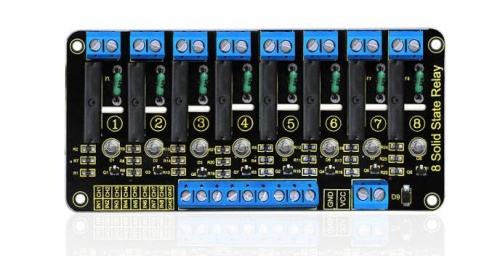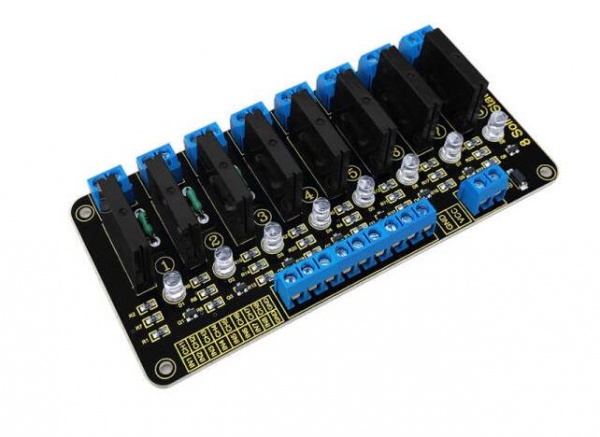Ks0266 keyestudio Eight-channel Solid State Relay Module: Difference between revisions
Keyestudio (talk | contribs) |
Keyestudio (talk | contribs) |
||
| Line 125: | Line 125: | ||
<br> | <br> | ||
==Resource == | ==Resource == | ||
* '''Code:''' <br> | * '''Code:''' <br> | ||
https:// | https://fs.keyestudio.com/KS0266 | ||
<br> | <br> | ||
==Buy from == | ==Buy from == | ||
Latest revision as of 10:21, 8 January 2021
Keyestudio Eight-channel Solid State Relay Module
Introduction
Keyestudio eight-channel solid state relay is active at HIGH level, that is to say, the input control signal is the high level (3.3-5 V), the relay is on; while the input control signal is low level (0-2.5 V), the relay is off.
Solid State Relay is a new kind of contactless switching device, which is composed of all solid state electronic components.
Compared with the electromagnetic relay, it has higher reliability, with the features of non-contact, long service life, fast speed and less outside interference.
The output control terminal of keyestudio solid-state relay must be connected to the circuit, can only be AC (Alternating Current) , so that the solid state relay can be disconnected normally.
Performance Parameters
- Electrical parameters:
| Voltage | Static Current | Working Current | Trigger Voltage | Trigger Current | |
|---|---|---|---|---|---|
| Channel 1 | DC 5V | 0mA | 13.8mA | 3.3-5V | 2mA |
| Channel 2 | DC 5V | 0mA | 26.8mA | 3.3-5V | 2mA |
| Channel 3 | DC 5V | 0mA | 37mA | 3.3-5V | 2mA |
| Channel 4 | DC 5V | 0mA | 48mA | 3.3-5V | 2mA |
| Channel 5 | DC 5V | 0mA | 59mA | 3.3-5V | 2mA |
| Channel 6 | DC 5V | 0mA | 70mA | 3.3-5V | 2mA |
| Channel 7 | DC 5V | 0mA | 81mA | 3.3-5V | 2mA |
| Channel 8 | DC 5V | 0mA | 90mA | 3.3-5V | 2mA |
- Output port: AC 100V/2A
Connection Diagram
Sample Code
int BASE = 3 ; //The first relay I/O port
int NUM = 8 ; //Total number of relay
void setup()
{
for (int i = BASE; i < BASE + NUM; i ++)
{
pinMode(i, OUTPUT); //Set the digital I/O port to output
}
}
void loop()
{
for (int i = BASE; i < BASE + NUM; i ++)
{
digitalWrite(i, HIGH); //Set the digital I/O port outputs to "HIGH", that is, gradually open relay
delay(200); //delay
}
for (int i = BASE; i < BASE + NUM; i ++)
{
digitalWrite(i, LOW); //Set the digital I/O port outputs to "LOW", that is, gradually close relay
delay(200); //delay
}
}
Result
Wiring as the above image, after powered-on, eight-channel solid state relays are first connected and then broken successively,repeating alternately.
Resource
- Code:
https://fs.keyestudio.com/KS0266


